ARTICLE
1
Comparative Analysis - The US M9 Series And Its Copies

| _____In
the later years of W.W.II, it became of importance
that the US Chemical Warfare Service develop a lightweight
gas mask for paratroopers and amphibious assault troops.
The British had already developed such a mask called
the Mk. I Light Anti-Gas Respirator (below left). Instead
of attaching the filter canister to the face piece
via a corrugated rubber hose, the Mk. I used a round
filter with a large opening that was screwed into the
left side of the face piece. This innovation enhanced
head mobility and also eliminated other problems with
dexterity caused by heavy filter canisters that were
worn around the chest or at the side. Breathing resistance
was also lowered because the soldier did not have to
draw air up through a heavy corrugated rubber tube,
as with most other W.W.II service gas masks. It is
likely that the British Mk. I was the inspiration for
the US M5-11-7 Assault Service Gas Mask (below center),
which was introduced in late 1943. The M5-11-7 went
on to be carried by US troops during the famous D-day
assault on Normandy, making it a significant W.W.II
collectable. The Assault Gas Mask was nothing more
than a altered US Army M3 Lightweight Service Gas Mask.
The chin area of the mask that usually had a hose attached
was sealed off and a 60mm filter inlet was integrated
into the left side of the neoprene face piece. A fabric
neck strap was also added to the head harness to keep
the face piece straight, as the mask had a tendency
to shift on the wearer's head due to the extra weight
on the left side. Despite the effort to create a serviceable
lightweight combat mask, the M5-11-7 was made of neoprene
rubber, and the face blank was prone to a stiffening
effect known as "cold
set". After the war, the C.W.S. set out to design
a better lightweight mask that did not have the problems found
with the M5-11-7. In the late 1940s, the E48 mask (below
right) was developed. The E48 was an early prototype of
the US M9 Field Protective Mask which was standardized
in 1947. There were a few early production M9s made from black rubber like the E48 (below left, 2nd row). However, the bulk of all standardized M9s produced were made entirely from natural gray-green rubber with a black rubber oronasal cup fitted on the inside to aid the demisting process. |
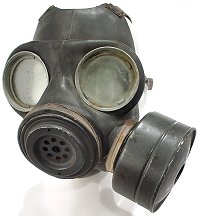
THE BRITISH MK. I LIGHT
ANTI-GAS RESPIRATOR |

THE US M5-11-7 ASSAULT
SERVICE GAS MASK |
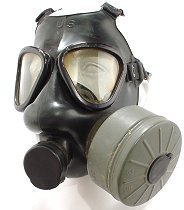
THE US ARMY E48 MASK |
| _____The
M9 was manufactured with a filter inlet on both the left
side (below center) and on the right side (below right) which
enabled either left or right handed weapon sighting. |
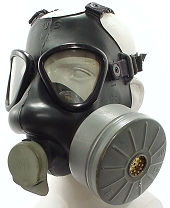
AN EARLY PRODUCTION M9 |

THE US M9 FIELD PROTECTIVE MASK |
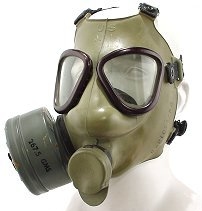
THE US M9A1
(RIGHT SIDE FILTER INLET) |
|
ABOVE: A US Marine ABC (Atomic/Biological/Chemical) team trains in Hawaii wearing M9 gas masks (July 1959). |
| _____The
M9's original carrier was an upgraded version of the earlier
M7 carrier (below left) which was issued with the M5-11-7
Assault Service Gas Mask. The M7 carrier was made of a rubberized
duck materiel that could be rolled and snapped shut to make
it water tight. The M9's carrier, designated the C15R1 used
the same water proofing concept but was made of an olive
drab duck materiel coated with rubber on the inside. Sometime
around 1950, the M9 was upgraded to the M9A1 after a new
carrier was introduced, designated the M11 carrier (below
right). The mask itself did not undergo any changes. |
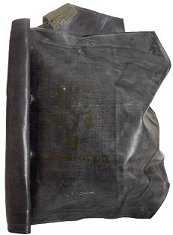
THE M7 CARRIER |
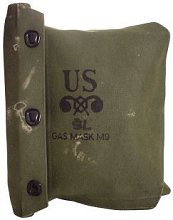
THE C15R1 CARRIER
|
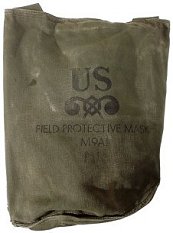
THE M11 CARRIER
|
|
|

|
The M9 fitted with the M-4 Toxicological Protective Hood |
THE US ABC-M21 ROCKET PROPELLANT GAS MASK |
THE US M15 COMPRESSED AIR BREATHING APPARATUS |
| _____The
M9 series mask came in three sizes: small, medium and large
and proved to be a very comfortable mask that offered a
high level of protection. To enhance the mask's protective capabilities, the M-4 Toxicological Protective Gas Mask Hood (above left) could be issued along with the mask. The face piece of the M9 was also
used for the M15 Compressed Air Breathing Apparatus (above
right) and the ABC-M21 Rocket Propellant Gas Mask (above
center). So successful, the M9 design was copied by at least
five countries, possibly more. The closest copies are undoubtedly
the Serbian M-1 and the Korean KM9A1. These masks used a face piece, head harness assembly,
filter and carrier that are virtually identical to the US M9.
There is also the Serbian MC-1 (a
civilian version of the M-1) made without the inner oronasal
cup. Another copy made in Sweden, was also very close in
design. The Skyddsmask-51 used a
dark green rubber face blank and a larger rubber exhale
valve cover, giving it a distinguishable appearance. In
Finland, a slightly modified clone was produced, designated
the m/61. There were several different m/61 variants manufactured, with the earliest type being also virtually identical to the US M9. The last version of the Finnish m/61 was manufactured with a peculiar hard plastic
exhale valve assembly which doubled as a voice-mitter. A
copy of the M9 was also produced by Bulgaria and was made of black rubber giving it an appearance very close to the Korean version. |

THE SERBIAN M-1 |

THE SERBIAN MC-1 |
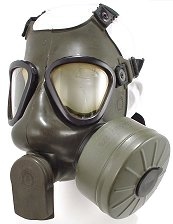
THE SWEDISH SKYDDSMASK-51 |
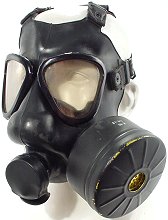
THE BULGARIAN M9 COPY |
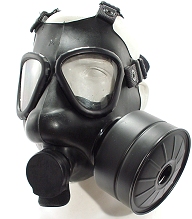
THE KOREAN KM9A1 |
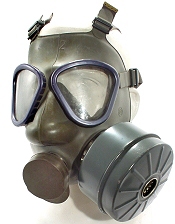
THE FINNISH M/61 (1st MODEL) |
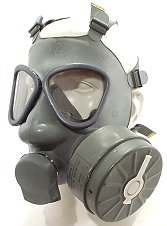
THE FINNISH M/61 (2nd MODEL) |
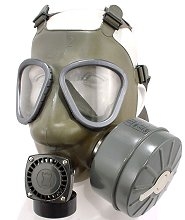
THE FINNISH M/61 (FINAL MODEL) |
| _____The US M9 series mask went on to be serviced by the US Army through the Korean War and all the way to the Vietnam era, where it was eventually phased out and replaced by the M17. |
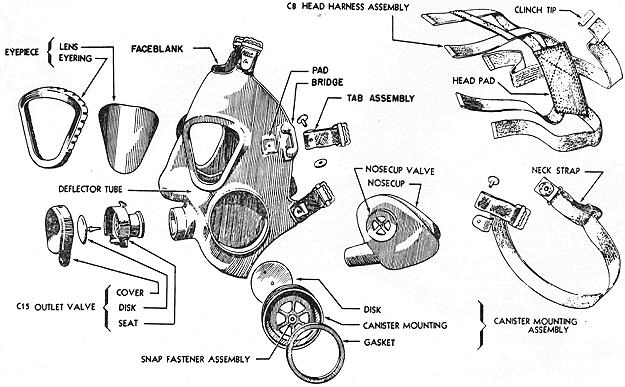
ABOVE: A DIAGRAM OF THE M9 EXPLODED
|
|
|
ABOVE: A diagram illustrating airflow through the M9. |
ABOVE: A photo of an early production M9 as worn. |
REFERENCES USED FOR THIS ARTICLE:
TM 3-205 - THE GAS MASK, MARCH 1951
TM 3-205/T0 14P4-1-31 - PROTECTIVE MASKS AND ACCESSORIES, APRIL 1955
TM 3-522-15 MASK, PROTECTIVE, FIELD, M9 AND MASK, PROTECTIVE, FIELD, M9A1,
OCTOBER 1957
U.S. CHEMICAL AND BIOLOGICAL DEFENSE RESPIRATORS
By Christopher T. Carey
|
|
| |
ABOVE: A worker wearing a protective suit and a M9 gas mask carefully moves some radioactive metal (ca. 1954). |
© NO FUTURE PRODUCTIONS
|
|